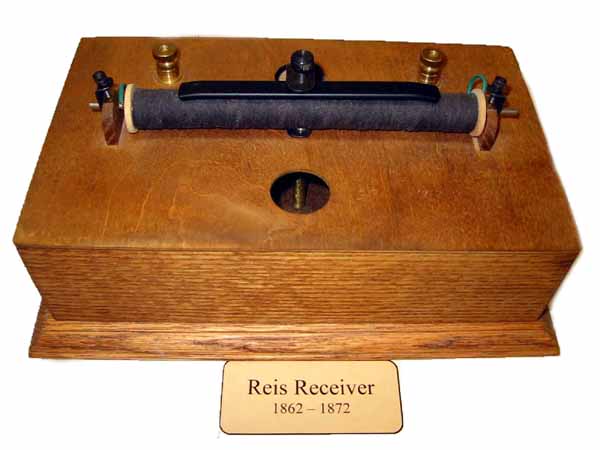The Reis Receiver 1862-1872

The Reis Receiver (developed before
A.G. Bell invented the telephone)
The instrument shown was
developed by Philipp Reis in the early 1860s and was used
as the receiver for his telephone transmitter. He was then
an instructor in physics (or natural philosophy, as it was
then called) in Friedrichsdorf, Germany. The Reis Receiver
was unique in telephone history, and he was the only one known
to have used this unusual design.
At first glance, one might
assume that it was simply another type of electro-magnetic
receiver, similar to those used by practically all of the
other early telephone experimenters. However, it did not work
by magnetic attraction and repulsion. Instead, it worked by
a little-known phenomenon called magnetostriction.
Magnetostriction causes
certain ferrous metals and alloys, an iron rod for instance,
to become longer or shorter when under the influence of a
fluctuating magnetic field. This effect was observed by several
early experimenters (J. Joule and C. G. Page) in about 1840.
Page noted that an electromagnet would emit a strange click
when pulsed with a sudden current, and deduced that the sound
was caused by the iron core of the electromagnet actually
changing its length under the influence of the surrounding
magnetic field. He called the effect “galvanic music,”
but found no practical use for it.
This was the technique
Reis chose to make the receiver for his telephone transmitter.
In his first implementation, he merely wrapped a coil of wire
(or helix as he called it) around an iron knitting needle
and stuck the needle into one of the S-holes in a violin,
which served as a sounding board. He later refined the design,
as shown in the illustration, by clamping the iron rod, surrounded
by a coil of wire, to a cigar-box type of resonator. The fluctuating
sound currents in the helix caused the rod to change its length
in step with the fluctuations, which, in turn, caused the
box to resonate. Note that there are no moving parts, per
se, in a Reis receiver. In fact, for the receiver to function
properly, it is essential that all the parts be tightly clamped
together.
Because the Reis receiver
requires a fairly high level of current, it is not as sensitive
as the common electro-magnetic receivers, although Reis was
able to transmit largely understandable speech. However, when
driven with a modern amplifier, it can generate enough volume
to be heard throughout a small room, and with a fidelity rivals
that of an inexpensive loudspeaker.
This page was written by
A. Edward Evenson, Author of the book The
Telephone Patent Conspiracy of 1876 available at Amazon.com